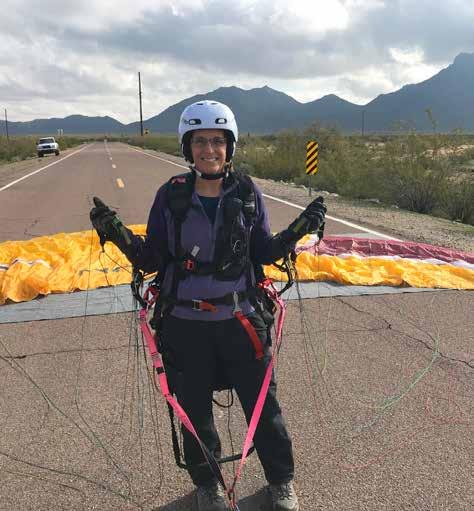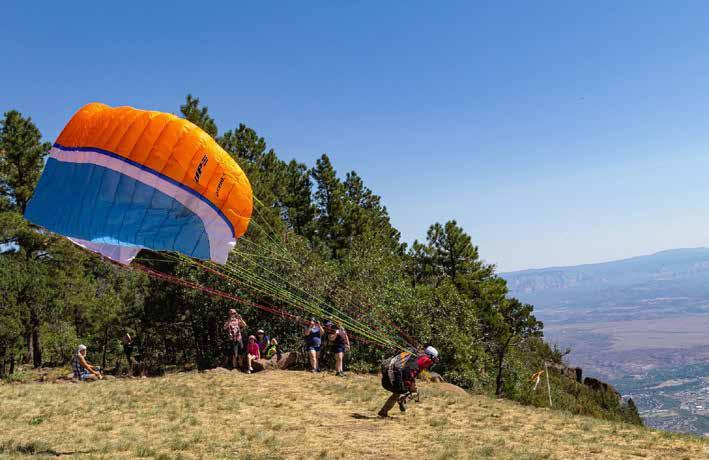
8 minute read
THE FLYING SENATOR
Arizona Senator Martha McSally takes to the skies
by LIZ DENGLER
A few months ago, I had the opportunity to chat with Senator Martha McSally of Arizona about her experience with free flight.
Her initial encounter with flight was not exactly traditional. McSally served in the United States Air Force for much of her early career. She was the first female fighter pilot (flying A-10 Warthogs) to serve in combat and command a flight squadron, spending much of her 26 years of service airborne.
When she retired from the Air Force in 2010 as a colonel, McSally found herself a new career as a professor at the George C. Marshall European Center for Security Studies in Garmisch, Germany—a role where her feet were firmly on the ground. “I was feeling some two-dimensional frustration,” said McSally.
It didn’t take long for McSally to find a way to return to the skies. “I would look out my office window and see these paragliders flying off the German Alps,” she said. So McSally and a friend, hungry for airtime, checked out the local paragliding school and she was quickly hooked. She took a leave from work and practiced every day in an 18-day course.
Once certified, she took to the skies as often as she could. “I would go flying sometimes at lunch. I was like, ‘Should I go to the gym, or should I go fly?’ My office was right by the cable car—so I’d change my clothes, take the cable car up, go fly for 20 minutes, pack everything up, and go back to work. It was awesome,” said McSally. She even flew into the winter, putting microspikes on her boots so she could launch off the snow without slipping.
However, in the winter of 2012, McSally once again felt the pull to serve her country, and she returned to the United States to run for Congress. As one can only imagine, her life got pretty hectic, and paragliding fell by the wayside.
In December of 2018, shortly after running for the Senate and losing, the Governor Doug Ducey of Arizona asked McSally to serve in the other vacant Senate seat, which would require her to run again in 2020. Accepting the opportunity, McSally also realized that she would need to find a way to “stay sane” with such a demanding position. She ruminated on the question, asking herself, “What do I need to do to ensure that I stay fit and balanced, spiritually, physically, and emotionally?” The answer was obvious to McSally. “I have to get back in the air. I gotta fly,” she said.
Though she technically could have converted over her rating from Germany, given how long it had been since she flew on a regular basis, McSally reached out to Aaron Cromer from Flying Lizard Paragliding in Tucson, Arizona to refresh and get certified as a P2. “I wanted to go through the basics again. I had had a lot in my brain since then,” she said. She worked with Cromer over the course of 2019, officially becoming a P2 on March 10, 2020.
With 2020 being an election year, she will have a lot less free time, but when time allows, she plans to be in the sky. “I want to do things that are going to refresh me and build me back up, and there is nothing like getting back in the air to do that,” she said. “There’s just nothing like—it’s an amazing experience. For me, in the

Senator Martha McSally getting ready to be towed up in Eloy, AZ
Photo by Aaron Cromer

Launching at Mingus Mountain, AZ
Photo by Aaron Cromer
role that I am in right now, it fills me up and brings me peace. I am able to really rejuvenate. I look forward to continuing to learn from the more experienced pilots, being a member of the community, and enjoying this extraordinary sport that we have,” said McSally.
Acquiring Access to New Sites Before we wrapped up, I spoke with Senator McSally about the best way for her fellow pilots to get engaged. Specifically, we spoke about gaining access to new sites or lands managed by federal agencies. McSally left us with a few tips: Do your research. Is it federal land or not? Knowing this is important for knowing who to reach out to. What is the issue, where are you trying to get access, and why is access currently not allowed. Reach out to local clubs and USHPA. Chances are there is some history with either the specific site you’re wanting to access or the specific land Reach out to the local represenmanagement agency that oversees tatives of the federal agency that the land. Talk to the local clubs first manages the land. Generally, these to find out the background on the representatives will be glad to work spot. When you need more informa- with you. Even if they can’t grant you tion or support, USHPA is there to access, they are usually willing to help too. There may be historical rea- respond in kind and give an explanasons why flying has not been allowed tion as to why. However, occasionally at a given site, and you don’t want to you may encounter unresponsiveness, start from scratch if you don’t have to. or feel that you might be getting Additionally, USHPA can coordinate “stonewalled.” If that happens, you can advocacy with other recreational reach out to your state representauser groups to help gain access as op- tives. portunities arise and can help raise Reach out to your Congress or national awareness within the flying Senate representative. Ask them to recommunity on specific initiatives. view your request and work on your
Put together a plan. Come up with behalf—that’s what they’re there for. a specific ask, address any potential As McSally said, “We write letters, we concerns in the proposal, and elect an make phone calls. We can ask ‘Hey, individual to spearhead the project. what’s going on with this?’ Nobody’s It’s better to have one point of contact getting special treatment. We ask rather than to send random requests what’s the law, what is the policy, and from all sides. Make sure to keep then we try to figure out how to help. USHPA informed of your efforts and If something takes an act of Congress they will work to assist you any way to shift, then that’s a whole other prothey can. cess we have to go through.”
Update on Recent USHPA Projects at the National Level
Free Flight in the National Parks As many members know, there is a prohibition against “the operation of aircraft” including powerless flight in national parks and recreation areas. However, many members may not realize there are special regulations to this clause that allow for free flight within a few select areas across the United States.. 36 C.F.R. § 7.97(b): “The use of devices designed to carry persons through the air in powerless flight is allowed at times and locations designated by the superintendent, pursuant to the terms and conditions of a permit.”
There are 10 national parks and recreation areas that allow free flight with applicable permits. • Golden Gate National Recreation Area • Sleeping Bear Dunes National Lakeshore • Indiana Dunes National Lakeshore • Whiskeytown Unit, Whiskeytown-Shasta-Trinity National Recreation Area • Point Reyes National Seashore • Appalachian National Scenic Trail • Blue Ridge Parkway • Delaware Water Gap National Recreation Area • Yosemite National Park • Shenandoah National Park
In addition, Lake Meredith National Recreation Area abides by the special regulation 36 CFR § 7.57(c): “The use of devices designed to carry persons through the air in powerless flight is allowed except in locations designated as closed to this activity. The superintendent may designate times and locations where such activity is allowed only under the terms and conditions of a permit.”
And Lake Mead National Recreation Area also allows for free flight, per 36 CFR § 7.48(b): “The use of devices designed to carry persons through the air in powerless flight is allowed except in harbors, swim beaches, developed areas, and in other locations designated as closed to this activity.”
These special accommodations allow for responsible operation of hang gliders and paragliders in several beautiful locations. Additionally, this foothold also allows USHPA to solicit additional access. Though there are generally tight regulations surrounding most national parks and recreation areas, USHPA has the ability to ask the Department of the Interior to remove, change, or modify those strict regulations through a Petition for Rulemaking. Since July, USHPA has been working with key volunteers on such a proposal to change the regulations that would provide more access throughout the park system.
It is likely there would still be a permitting process to fly in these locations, but successfully changing these regulations would open new sites, launches, and landing zones for our ever-growing free-flight population. As USHPA moves through the process, they will be reaching out to the free-flight community once a commenting period opens. During that time, members can reach out and show their support.
Tariff Bill USHPA has been working on a Miscellaneous Tariff Bill (MTB) to eliminate the 3% import tariff on paragliders and related gear. Since the Customs and Border Patrol (CBP) claimed it would be too difficult to discern which items will be subject to tariff relief for paragliders (including parts and accessories), USHPA responded in mid-June with a rebuttal to clarify the process and provide some streamlined alternatives for the CBP to identify items. In early August, USHPA received approval to the revisions for eligible items. The proposal for tariff relief, now limited to wings and harnesses, will become a bill and hopefully approved by Congress before year end.
Monitoring Drones With the growing use of recreational and commercial drones, the FAA continues to be concerned with the visibility of ever-increasing air traffic. There is consistent pressure for all aircraft to carry some form of identification or beacon. USHPA, along with other stakeholders, is working to protect our current status as ultralight pilots and be exempt from such a requirement. They are working to determine a clear way forward that will ensure the visibility of free flyers, without forcing additional cost on recreational participants.
If you would like to stay apprised of work USHPA is doing, check out our new Advocacy Page: www.ushpa.org/advocacy

Arizona Senator Martha McSally and USHPA Executive Director Martin Palmaz in Washington, D.C.

